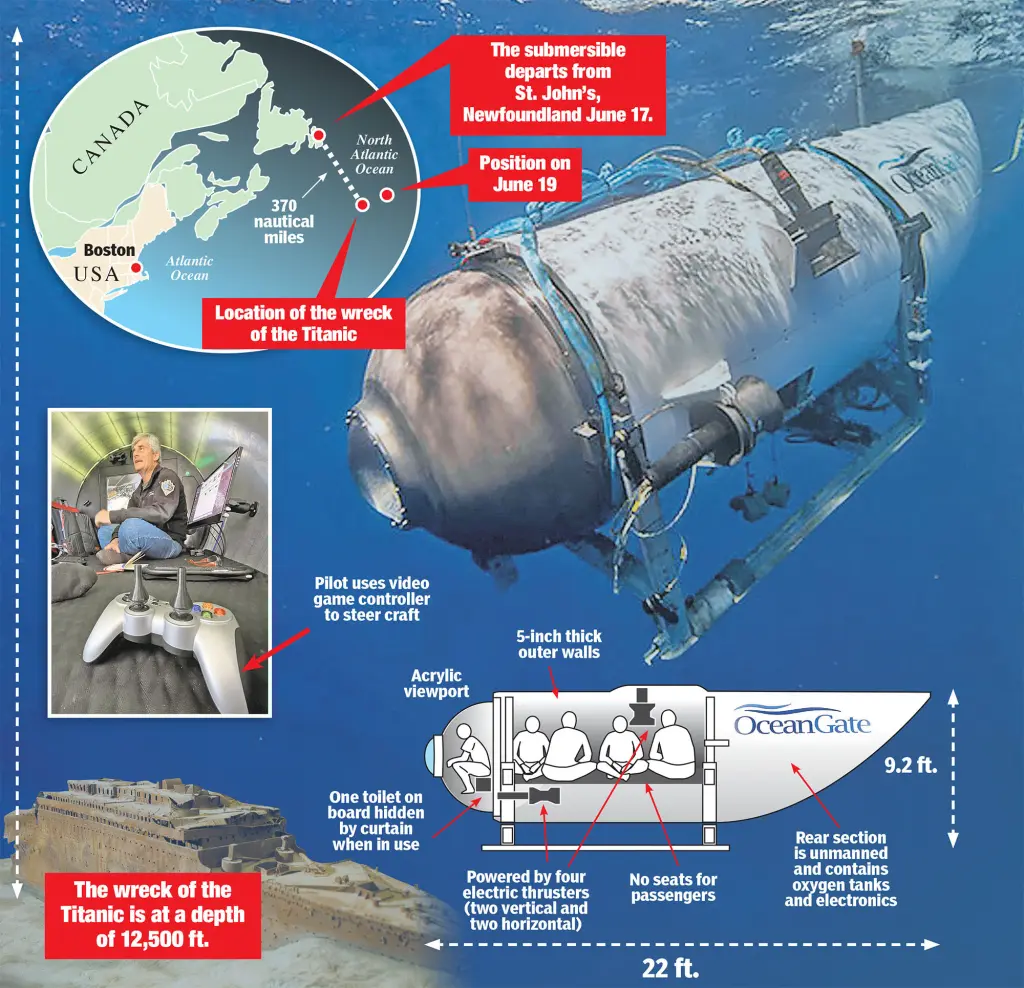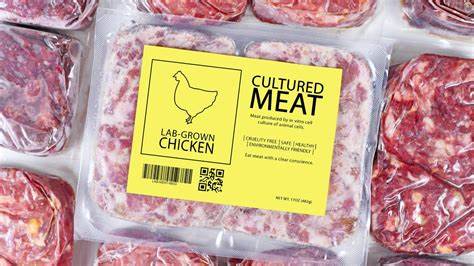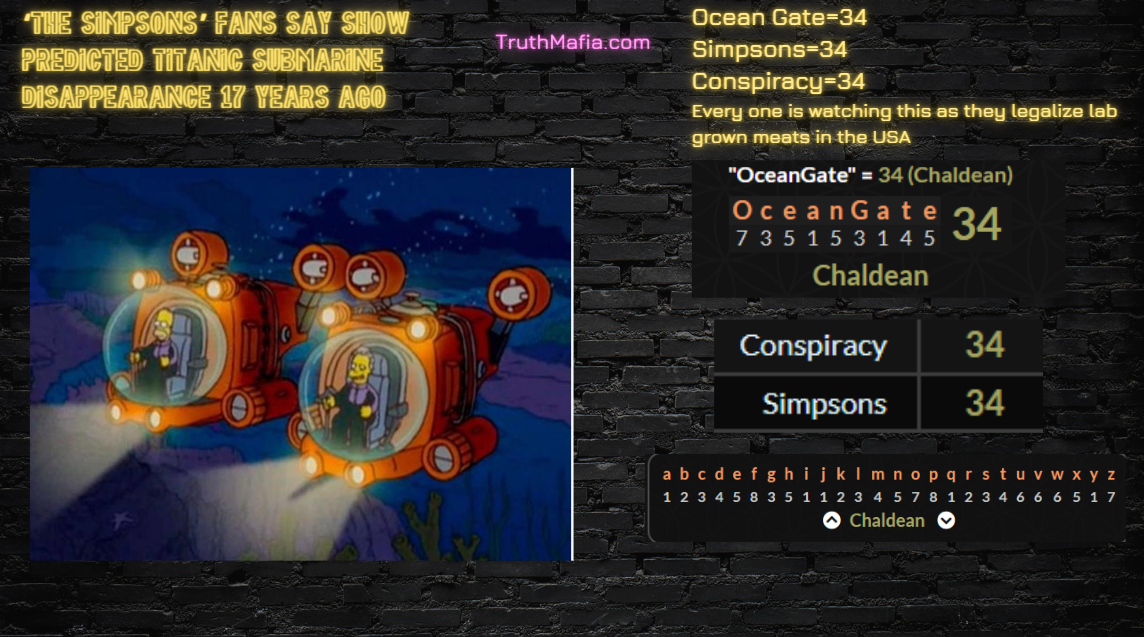
Titanic submarine Decode Doenut and Juan on Juan
“The Simpsons” and its eerie ability to foresee future events. Once again, the animated series has sent shockwaves through the fabric of reality. This time, it appears that the show might have foreshadowed the disappearance of the OceanGate submersible during its exploration of the Titanic wreckage.
“OceanGate” = 34 Chaldean, Simpsons=34.
Click on Image to Enlarge

The Simpsons’ Predictions Strike Again: Missing Ocean Gate Submersible
The Simpsons has been on-air for over three decades and has made numerous predictions that seem to be coming true. From the election of Donald Trump to the COVID-19 pandemic, the long-running animated series has been eerily accurate in predicting future events. And now, it seems like the show has done it again. In not one but two episodes, The Simpsons may have predicted the missing OceanGate submersible and its tragic outcome. Let’s take a closer look at the possible connections between the show and the real-life event.
The first reference to a submarine on The Simpsons can be seen in Season 9, Episode 19, titled “Simpson Tide.” After losing his job at the nuclear power plant, Homer enlists in the Navy and finds himself on a submarine. When an explosion causes a pinhole leak in the vessel, Homer and his friends panic and eventually save themselves by plugging the hole with Bart’s earring. Although this reference is not directly related to the missing submersible, it is still a coincidence worth noting.
A more significant connection can be found in Season 17, Episode 10, titled “Homer’s Paternity Coot.” In this episode, Homer and his long-lost father search for treasure in individual submarines. Homer gets stuck in some coral and runs out of oxygen, leading him to fall into a coma. When he wakes up, he finds himself in a hospital three days later. This episode’s plot bears an uncanny resemblance to the real-life events surrounding the missing OceanGate submersible.
On June 22 OceanGate announced that their Titan submersible and its five passengers were likely imploded and presumed dead. The show’s episode, which originally aired in 2006, features a submarine getting stuck and its passenger running out of oxygen. Although the two events are not identical, the similarities are hard to ignore.
These coincidences have led many to speculate about The Simpsons’ predictive powers. The showrunners and writers have dismissed the claims, stating that they cannot predict the future and all predictions are merely coincidences. However, with so many accurate predictions under their belt, it’s hard not to wonder if there is something more going on.
Furthermore, The Simpsons is not the only show to have made unexpected predictions that seem to come true. Shows like Black Mirror, The X-Files, and even The Twilight Zone have made predictions that have come to fruition in reality. Perhaps it is a testament to the power of art and the ability of artists to tap into the collective unconsciousness of society.
While it’s impossible to say for sure whether The Simpsons’ predictions are intentional or mere coincidences, the similarities between the missing OceanGate submersible and the show’s episodes are hard to ignore. Whether the show’s writers are prophets or not, one thing is certain: The Simpsons remains one of the most influential and groundbreaking shows in television history. And who knows? Maybe there are more predictions to come.
Sale of Lab-Grown Meat Now Legal in the United States: A Breakthrough in Compassionate Consumption

The legalization of lab-grown meat, also known as cultivated meat, in the United States is a promising development for the compassionate consumption movement. The acceptance of this innovative technology by the US Department of Agriculture (USDA) is a breakthrough that is set to revolutionize the way we consume meat. In this blog post, we will explore the consequences of this new law and its impact on the food industry, the environment, and the health of individuals.
Good Meat, a subsidiary of Eat Just, is among the first companies to receive approval from the USDA to produce cultivated meat. With this green light, Good Meat has already begun production of their cell-based proteins referred to as “cultivated chicken.” The process involves growing meat in large tanks under controlled conditions similar to those used in beer breweries.
This recent development builds upon previous approvals that have paved the way for the sale of cultivated meat in the US. In March, Good Meat received a letter from the Food and Drug Administration (FDA) stating that the product is safe for sale in the US. Upside Foods also received a similar letter from the FDA in November. Both the USDA and the FDA are responsible for overseeing the emerging cultivated meat industry.
Cultivated meat is a concept that would allow for meat consumption without the need for animal slaughter. Good Meat and Upside Foods believe that cultivating meat in this way could help combat climate change. This sentiment is shared by many supporters of the technology. They believe that this innovative approach to meat consumption has the potential to alter our DNA and move us towards a more ethically and environmentally sustainable future.
Good Meat, whose products are already being sold in Singapore, promotes its offerings as “meat without slaughter.” This approach to meat has garnered a lot of attention from individuals looking for alternative ways to consume meat. By using this technology, consumers can continue to enjoy the taste of meat while not having to worry about the environmental or health consequences of traditional meat consumption.
The legalization of cultivated meat by the USDA is a promising development that will change the way we consume meat. The emergence of this technology presents an opportunity to move away from traditional meat consumption, which has a massive environmental impact and ethical implications. Advocates of the technology believe that it could be the key to saving the planet, and it is an exciting time for the compassionate consumption movement. While there is still much research to be done before this new method of meat production becomes the norm, this green light by the USDA marks a significant milestone in the journey towards a more ethical and sustainable future.






I don’t think I care for any lab grown meat, just saying